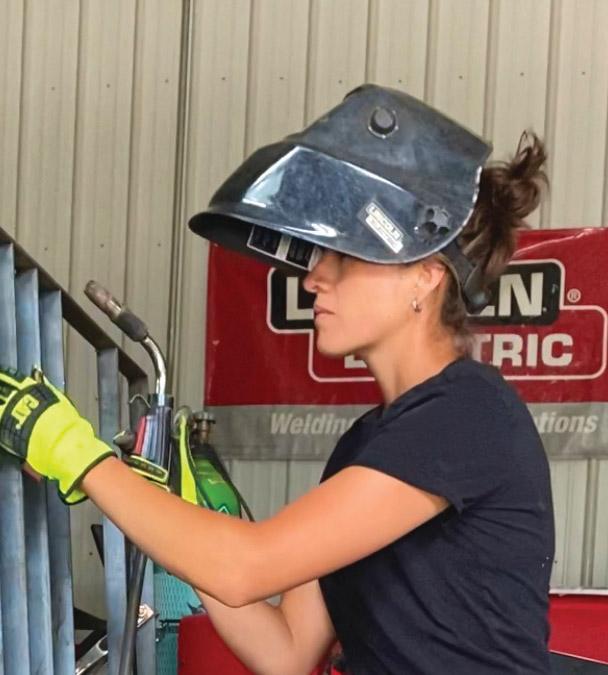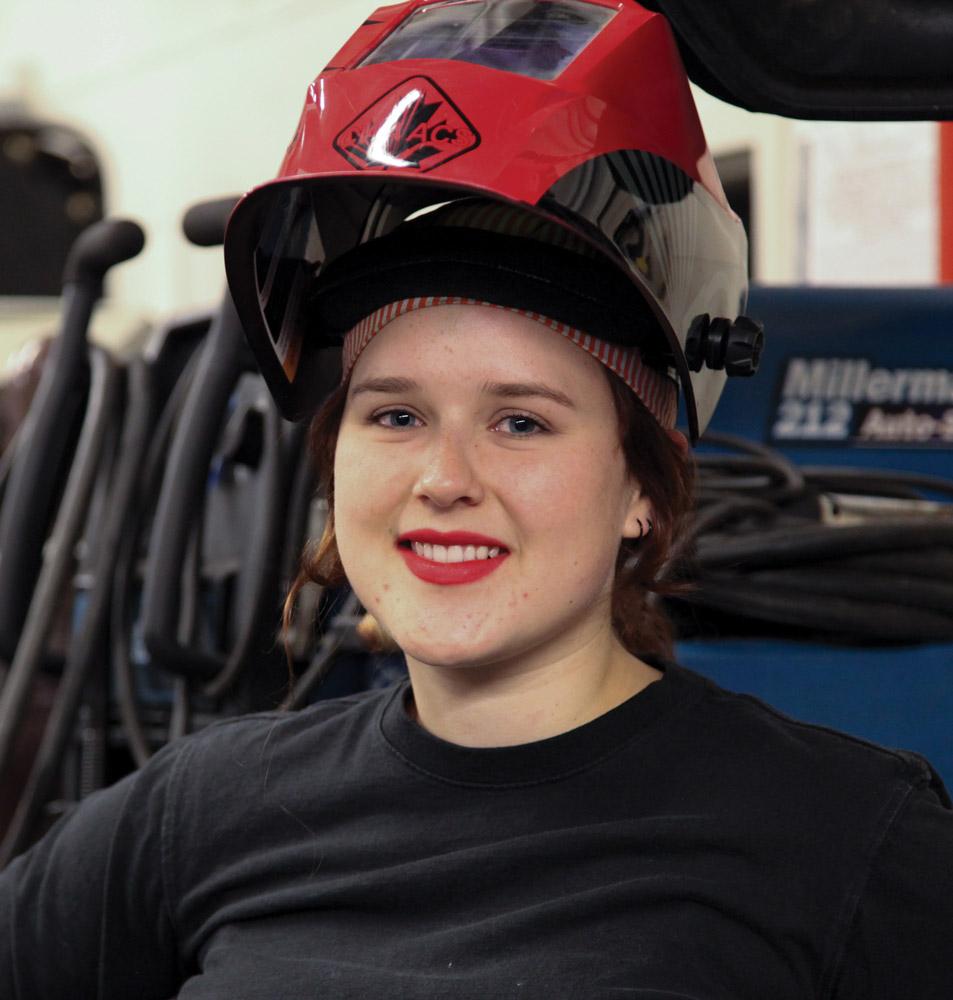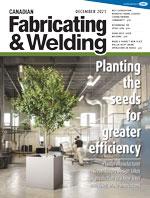Editor
- FMA
- The Fabricator
- FABTECH
- Canadian Metalworking
Next-Generation Manufacturing Leaders: Strengthening community
By encouraging connection, these leaders are building industry resilience
- By Rob Colman
- December 23, 2021
- Article
- Welding
It seems that at every event I attend someone is discussing labour shortages in manufacturing. Everyone understands that it is essential to build a pipeline of new talent for the industry’s future, but it’s not always clear how to do so.
In this issue of Canadian Fabricating & Welding, we introduce you to four individuals who are working to build that pipeline in different ways – by being highly visible in the community, by reaching out to students, by leading and encouraging involvement in industry associations, and by creating safe spaces for talents to grow.
Kathryn Corbiere, Owner, OneKWE
Kathryn Corbiere got started in welding by taking a course in Sudbury to get her CWB ticket. When she wasn’t immediately able to secure work as a welder, she began creating modern, steel-framed furniture that fit an aesthetic that she liked.
“I then became friends with a local machinist who took me under his wing and taught me how to use a CNC plasma machine,” she said. “Once I was comfortable cutting shapes and designing on the machine, as well as using a mill and lathe, I started doing some simple sign work. The jobs gradually got larger, and I soon found myself answering calls for public sculptures that I was interested in.”
OneKWE means “one woman” in Ojibwe. Although OneKWE is a fabricating business that makes everything from signs and furniture to custom fab work of every description, it has been public artwork in which Corbiere celebrates her heritage that has put her in a more public spotlight than many fabricators experience.
The first commission she took on was a Canada 150 project that stands on the north channel of Manitoulin Island in Ontario, where Corbiere lives and operates her business on the M’Chigeeng First Nation.
“That first installation consists of three trees – two tall trees made of 3/8-in. aluminum that have branches in the shape of the Great Lakes, paying homage to the water of the lakes, with a shorter Jack pine made of mild steel between them that blends with the trees in the surrounding landscape,” she explained.
Corbiere also has helped to create an art piece with Pride Manitoulin’s youth group for the island’s first pride week that is now featured at the Ojibwe Cultural Foundation. In addition, she completed a sculpture project in partnership with Toronto artist Kwest. It is a 16-ft. piece that sits in front of Manitoulin Secondary School’s new entrance. Made of 1/8-in. steel, this piece was formed to appear as fire, and placed around the sculpture in the appropriate directions are 3D animal clans.
Most recently she unveiled her 15-ft.-long Nookomis Gitche Name’ Kwe (Grandmother Sturgeon) sculpture, which features prominently in the Healing and Reconciliation Garden at Kelso Beach in Owen Sound, on the traditional territory of the Saugeen Ojibway Nation.
“Both of my grandmothers are residential school survivors, so having this opportunity to create a grandmother sturgeon connected me to the work in another way,” said Corbiere.
Watch for a more extensive look at this installation in a future issue of the magazine.
Corbiere gives back to the community through her artwork but also through outreach with students. Beyond working with Pride Manitoulin’s youth group, she has also been involved in a Women in Welding program at a local trade school and is now sponsoring Manitoulin Secondary School’s robotics team.
“They have a lot of younger students who are new to the team who will have a chance to visit my shop, where I’ll teach them how to use basic tools because they will have to build their own robot from scratch out of aluminum and steel,” she explained. “I hope to inspire them by helping them use my CNC to build their robot.”
Corbiere appreciates how connecting to the trades can make a difference for many young people.
“Trades are an excellent opportunity,” she said. “Take me back six years and I had no idea about CNC cutting, but once you get started and troubleshoot your way through it, there’s a lot of learning along the way. It’s about being open, being willing to make mistakes and learn from the people who are trying to teach you. That’s how I’ve grown.”
Corbiere currently is busy working on a corporate project and hopes to do more architectural-related, structural design work in the future.
“My shop is growing year after year,” she said. “While I primarily do cutting, welding, and assembly, eventually I hope to acquire other equipment to expand my capabilities.”
Gentry Wood, R&D Engineer, Apollo-Clad Laser Cladding
Gentry Wood first got involved with welding research in one of his introductory materials engineering courses in his third year of undergraduate studies. Dr. Patricio Mendez, his instructor for the course, was head of the Canadian Centre for Welding and Joining (CCWJ) at the University of Alberta. Wood and Mendez developed a rapport through the semester, and Wood was invited to work on some extracurricular research under Mendez’ guidance and that of his graduate students at the CCWJ.
This began Wood’s involvement with research, leading him to the doors of the Canadian Welding Bureau Association (CWBA), which has played a pivotal role in his career and led to his current leadership roles within the Canadian welding industry.
“Patricio encouraged my involvement in the student chapter of CWB at the university because it offers a critical part of professional development outside of our school education,” said Wood. “It’s a great opportunity to travel, to present research, and to network with others in the welding field.”
Wood eventually became president of the CWB’s University of Alberta student chapter while pursuing his PhD at the CCWJ on the topic of laser cladding overlays for wear and corrosion protection.
“It gave me a chance to attend conferences and also be involved with the CWBA’s National Advisory Council, where I got to know the people involved, the culture, and the goals of the organization,” he said.
Wood’s day job as a research and development engineer for Edmonton-based Apollo-Clad Laser Cladding, a division of Apollo Machine and Welding Ltd., involves working on optimizing laser-based coating processes, improving efficiency, and maximizing productivity.
“As metallurgists, our team looks at the chemical composition of our coatings and what impact that will have on product performance,” he said. “We develop our custom coatings for applications from the alloy design phase through to the laser welding deposition process, and that really opens the doors to tailoring the end product to what the customer needs. The possibilities are pretty much infinite, which makes it a challenge and great opportunity to find the best solution.”
Wood’s involvement with the welding community and technical societies didn’t slow down when he graduated with his PhD in 2017. He is now an expert delegate of the Canadian Commission of the International Institute of Welding (CCIIW) in Commission IV on Power Beam Processes, a member of the American Welding Society (AWS) Technical Papers Committee, chair of the CWBA National Advisory Council, and in his spare time, chair of the local CWBA Edmonton Chapter.
Wood is very proud of his local chapter work in Edmonton.
“Our entire executive team are former students from the CCWJ,” he noted. “Many technical societies struggle to get young people involved, so I’m really proud that our whole executive team is under the age of 35. We have a vibrant young core of welding professionals that are passionate about our Canadian welding industry.”
The chapter holds regular dinner meetings that include both local speakers and professionals in other areas of the welding industry from across Canada.
“We are lucky that with our connections at the university and industry friends, we’re able to bring in very interesting speakers from further afield who can teach us about areas of the industry that we may not connect with regularly here in Alberta. There’s always a lot to learn, and after a decade I still look forward to our technical dinner meetings.”
The chapter also awards scholarships locally: one at the Northern Alberta Institute of Technology (NAIT) and a graduate and undergraduate award to deserving students from the CCWJ.
“We’ve prioritized as a chapter building and growing this scholarship program as part of our mission to support and educate the next generation of welding professionals,” said Wood. “A great side effect of this student support is that many of our scholarship winners stay connected and involved with the CWBA and our chapter in their professional careers.”
Mackenzi Johnston and Jolene Borrelli, Co-founders, The Red Bench
Sometimes it takes a while to find your path in life and work. Sometimes the longer it takes, the more determined a person is to succeed. Both Mackenzi Johnston and Jolene Borrelli are good examples of this. Johnston spent a year at Carleton University in engineering and the following year learning how to weld while taking courses at Southern Alberta Institute of Technology (SAIT) before choosing to study materials engineering at the University of Alberta. She became a member of the Canadian Centre for Welding and Joining (CCWJ) shortly thereafter as an undergraduate researcher in hydrogen testing. Among other pursuits, Borrelli was trained as a horticulturalist and a JavaScript programmer before also focusing on materials engineering at the U of A. She became a member of the CCWJ as an undergraduate researcher in Charpy impact testing.
Pre-pandemic, Johnston was approached by a number of her female colleagues asking her to teach them how to weld; although they were doing materials and welding-related research, none had ever held a welding torch or welded a bead.
“I was just showing them basic welding equipment safety and how to do a few simple welds,” said Johnston. Borrelli was one of the attendees. “All of the women gained so much confidence and knowledge in their studies. And I didn’t just have women who were in engineering, there were women from other disciplines as well. Both Jolene and I really enjoyed the sessions, so when COVIDput an end to them, we decided we needed to keep the momentum going. We wanted to take the idea out of the university and into the community.”
From this, the concept for The Red Bench was formed.
“We are creating The Red Bench as a community shop for women in Edmonton,” said Borrelli. “It will be a space where women can gain confidence, meet mentors, and hone technical skills in a casual, community-driven environment. In the beginning we will have group projects that we will work on together and volunteer-led workshops from industry professionals. Eventually we want to have the space opened to self-directed projects. We are there to connect mentors to mentees and to facilitate what goes on in the space.
“Our hope is to draw women to the skilled trades and technology and encourage them to pursue educational and professional opportunities that align with their technical interests,” Borrelli continued. “We want women to not only enter into industry, but to stay there and feel like they belong.”
Borrelli herself has experienced the challenge of having nowhere to practice her new welding skills.
“I took gas tungsten arc welding classes at NAIT, but after I finished the course, I had nowhere to practice,” she said. “If we want women to enter the trades, it’s important that they have safe spaces where they can comfortably practice and develop their skills.”
The Red Bench encourages women above 18, from all walks of life, to take part. Their membership base already includes newcomers to the trades, seasoned tradeswomen; hobbyists; and university, college, and continuing education students as well as graduates.
Johnston and Borrelli are still in the process of raising funds to meet the cost of the shop’s insurance and utilities payments for their first year of operation. At this stage, they have raised more than half the money necessary and secured a shared space with a welding engineering firm in Edmonton, Canwe Solutions Ltd. It’s a testament to their determination that in a short year and a half the pair have achieved so much while alternating between university classes and co-op placements.
“We are both incredibly driven; we are determined to succeed in this,” said Borrelli. “And in the process, we have developed so many skills – from learning how to write a business plan to running a fundraiser and cultivating a social media presence.”
“We are developing so many skills beyond our engineering degree,” Johnston said. “That is such an important part of being a professional in an industry like this.”
The next step for the pair is to secure equipment for the shop.
“We have already had offers from a number of individuals who plan to donate some tools, and we are hoping to encourage the donation of older equipment that shops plan to retire as they buy new equipment,” said Johnston. “We are confident that we will be able to source what we require. It’s looking very positive thanks to the strong, organic support we receive.”
To learn more, visit their website at theredbench.ca.
Editor Robert Colman can be reached at rcolman@canadianfabweld.com.
About the Author

Rob Colman
1154 Warden Avenue
Toronto, M1R 0A1 Canada
905-235-0471
Robert Colman has worked as a writer and editor for more than 25 years, covering the needs of a variety of trades. He has been dedicated to the metalworking industry for the past 13 years, serving as editor for Metalworking Production & Purchasing (MP&P) and, since January 2016, the editor of Canadian Fabricating & Welding. He graduated with a B.A. degree from McGill University and a Master’s degree from UBC.
subscribe now


Keep up to date with the latest news, events, and technology for all things metal from our pair of monthly magazines written specifically for Canadian manufacturers!
Start Your Free Subscription- Industry Events
Automate 2024
- May 6 - 9, 2024
- Chicago, IL
ANCA Open House
- May 7 - 8, 2024
- Wixom, MI
17th annual Joint Open House
- May 8 - 9, 2024
- Oakville and Mississauga, ON Canada
MME Saskatoon
- May 28, 2024
- Saskatoon, SK Canada
CME's Health & Safety Symposium for Manufacturers
- May 29, 2024
- Mississauga, ON Canada
























